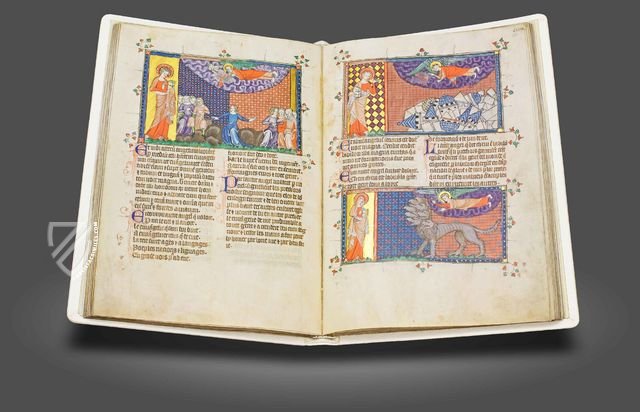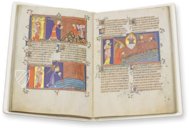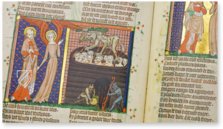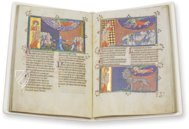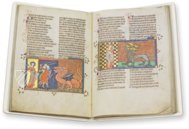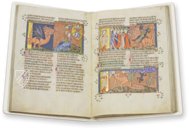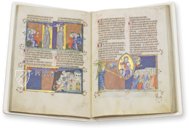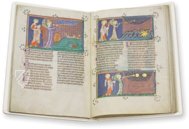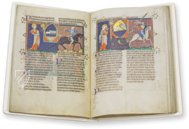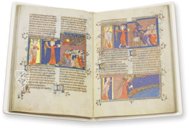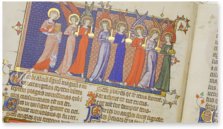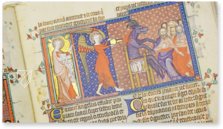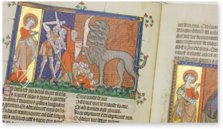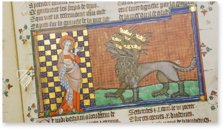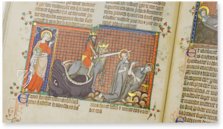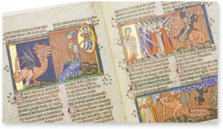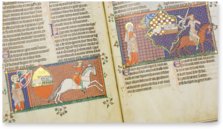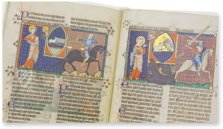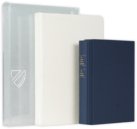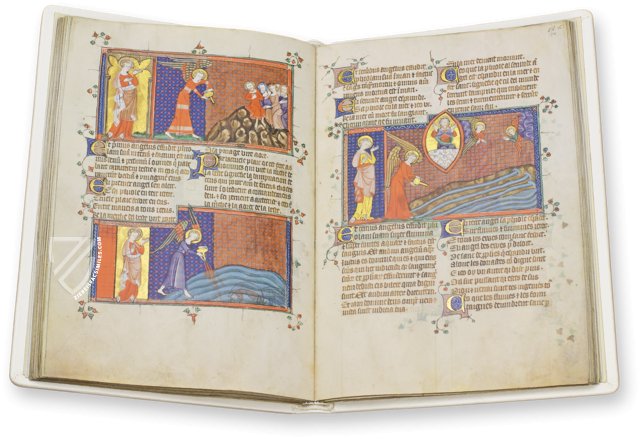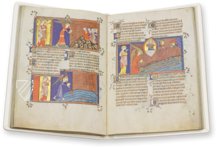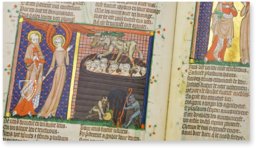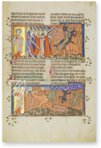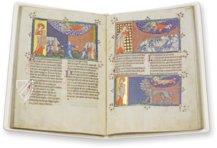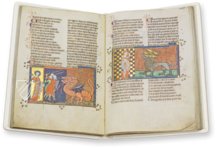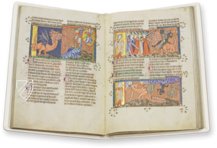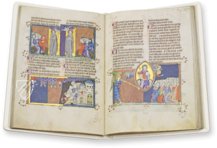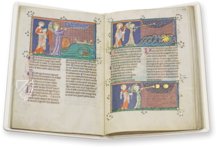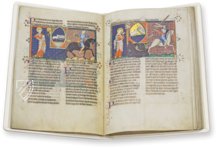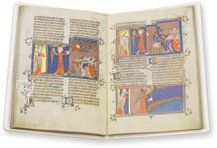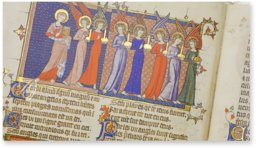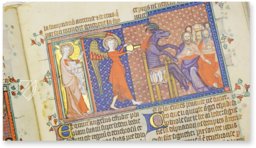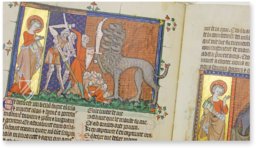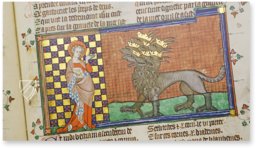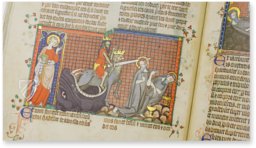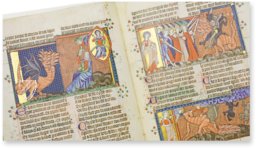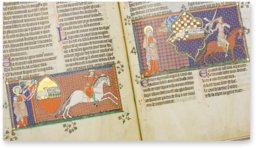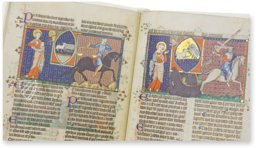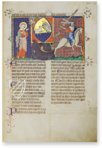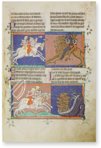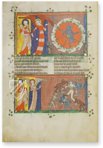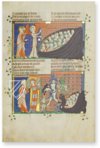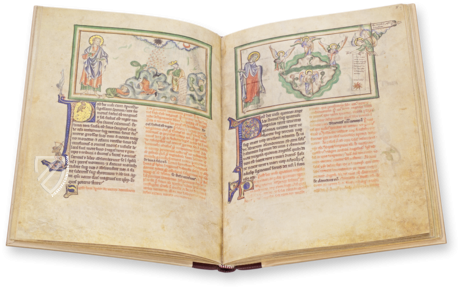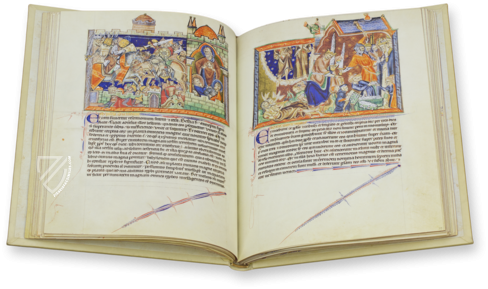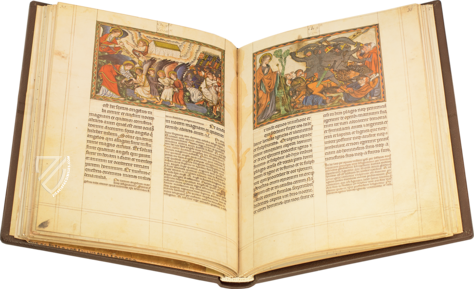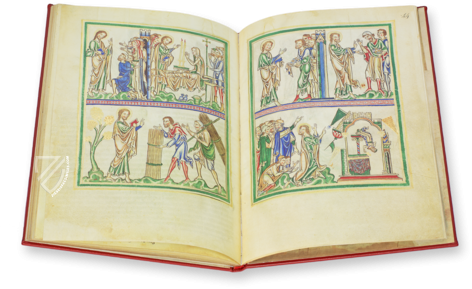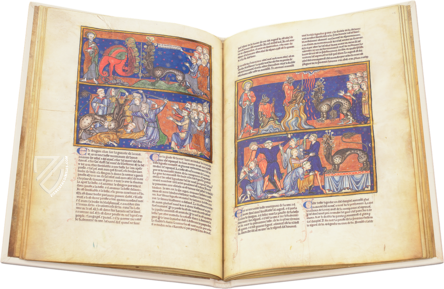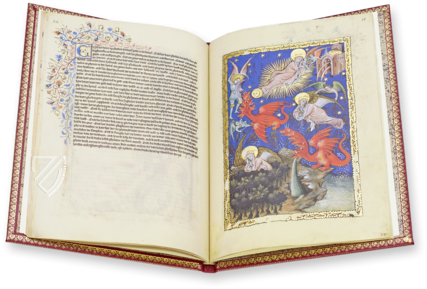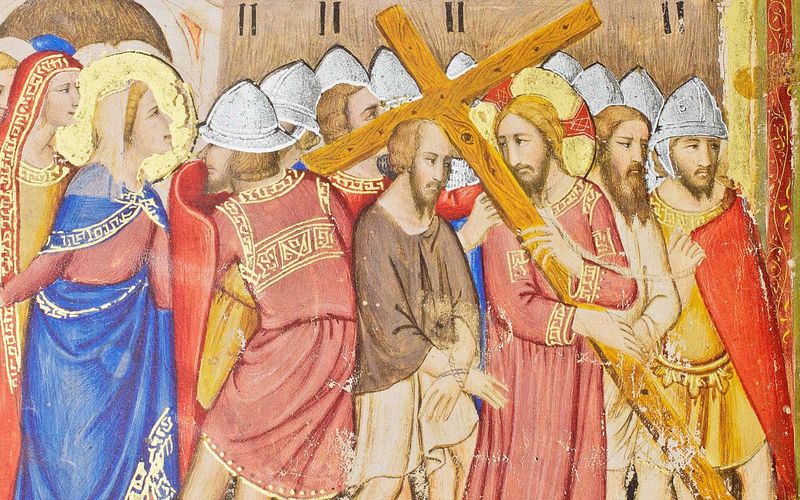Corpus Apocalypse
(3,000€ - 7,000€)
The Corpus Apocalypse is a codex which originates from England in the 14th century, specifically between 1340 and 1350. The artwork depicts John's revelations and Paul's end-time vision in a never before seen wealth of pictures with gold and silver inlays. The pictorial and symbolic biblical text of the Apocalypse had a significant influence on Western culture. Containing numerous miniatures, the Corpus Apocalypse is considered to be one of the most artistically valuable editions of the text. Additionally, it contains the English Coronation Order of 1308, which was personally attended by the patrons the Lords of Cobham. No expense or effort was spared to capture this personal memory in the magnificent manuscript. The text of the manuscript was written down in work step and is in Latin and Anglo-Norman. The bilingual verses are a special feature of English book art at the time and made this precious work popular beyond the borders of England.
Corpus Apocalypse
The last book of the New Testament, namely the Book of Revelation, was generally referred to as the Apocalypse. The revelation contains visions of the Day of Judgement, the end of the world, and finally the dawn of God’s Kingdom. This very vivid and symbolic biblical text had a strong influence over the whole of occidental culture. The Corpus Apocalypse is the richest in imagery and most artistically valuable edition of this text. It originates between 1340 and 1350 and contains the Coptic Apocalypse of Paul in addition to the Book of Revelation, as well as a transcript of the English coronation rules. In total, the 144 pages of text are illustrated with 121 extensive miniatures on a gold and silver background, with 280 blue initials in fire read intertwined tendrils and 59 high-quality gold initials.
Commissioned by a Venerable Family
The magnificent manuscript originates from the commission of the Cobham family. The Lords of Cobham were great landholders in southeastern England and high officials of the English court. Lord Henry Cobham, chief justice of the treasury at Westminster, had taken part in the coronation of Edward II in 1308. His son John, who most likely commissioned the codex, was likewise an attendant at a coronation, namely that of King Edward III in 1327. The coronation rules in the codex were a very personal remembering of the esteem and dignity that the family experienced with the participants of this ceremonial act. The masters who created this work are not known by name. Nevertheless they shirked no cost or labor in the furnishing of this valuable jewel.
An Eventful History
After the death of its commissioner, the Corpus Apocalypse entered into the possession of the English noblewoman Juliana de Leybourn. After her death in 1337 she bequeathed the manuscript to Benedictine Abbey of St. Augustine in Canterbury, which was dissolved in the early years of the Reformation. The book collector Mathew Parker succeeded in saving hundreds of codices from the abbey, including the Apocalyptic text. Parker, who served as the director of the Corpus Christi College in Cambridge, was named Archbishop of Canterbury in 1559 by Elizabeth I and therewith head of the Church of England. He bequeathed to his erstwhile college an enormous collection of manuscripts, among which was the Apocalypse. To this day the codex is in Cambridge and is one of the oldest and costliest works of the Parker Library.
Uniquely Rich Illustrations
There is no other manuscript of the Book of Revelation that exhibits a similar wealth of miniatures. One or possibly two gifted masters appointed the work with magnificent, artistic, and inconceivably elaborate pictures. The miniatures are painted in luminous colors on a shimmering gold background, which are designed with the help of the finest tools. There are numerous silver elements to be rediscovered in the miniatures. For the first time, the Coptic Apocalypse of Paul is visually represented with an impressive pictorial cycle. The text pertaining to the coronation rules are heralded with whole page, festive miniatures.
An Unusual Text Combination
The Corpus Apocalypse consists of three bodies of text, first the Book of Revelation, thereafter follows the Coptic Apocalypse of Paul, and closes with the coronation rules of 1308. It was normal for medieval codices to combine different texts in one book. Nevertheless the Corpus Apocalypse was recorded in a single task. The text was completed in two languages, namely Latin and Anglo-Norman, the language of the English nobility at that time. In this way, it was guaranteed that the commissioner could read and understand his work in a familiar language.
Codicology
- Alternative Titles
- Parker Library MS 20
Corpus-Christi-Apokalypse
L'Apocalypse de Cambridge
Cambridge Corpus Christi MS 20 - Size / Format
- 144 pages / 37.0 × 26.0 cm
- Origin
- United Kingdom
- Date
- 1340–1350
- Epochs
- Style
- Genre
- Script
- Gothic Textura Quadrata
- Illustrations
- 121 large-format, richly decorated miniatures, 280 blue initials with red flourishing, and 59 gold initials
- Content
- The Book of Revelation, the Coptic Apocalypse of Paul, and the English coronation rules of 1308
- Patron
- Probably John de Cobham, 2nd Baron Cobham (d. 1355)
- Artist / School
- One or two masters in London working in the Flemish style
- Previous Owners
- Juliana de Leybourn, Countess of Huntington (1303/04–67)
St Augustine's Abbey, Canterbury
Matthew Parker, Archbishop of Canterbury (1504–75)
Corpus Apocalypse
The Beast and His Armies Defeated
Riding white horses, beautifully adorned in high medieval armor and wearing golden crowns, the heavenly host is depicted routing the Beast and his armies, driving them into the Hellmouth. “Then the beast was captured, and with him the false prophet who worked signs in his presence, by which he deceived those who received the mark of the beast and those who worshiped his image. These two were cast alive into the lake of fire burning with brimstone.” (Rev. 19:20)
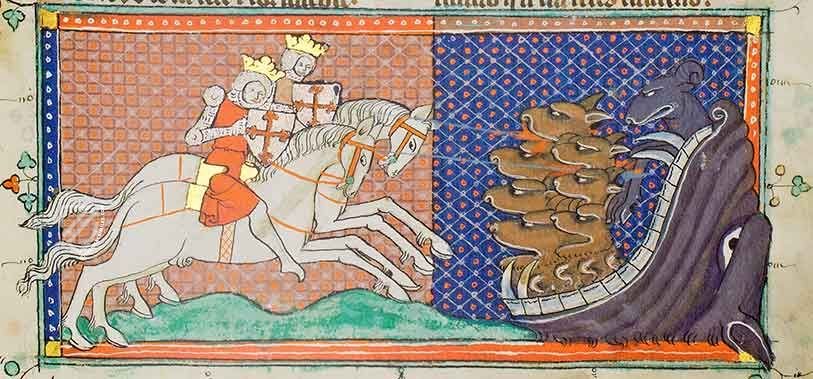
Corpus Apocalypse
The Pale Horseman
This splendid miniature depicts one of the most chilling verses from the Bible: “And I looked, and behold, a pale horse, and his name that sat on him was Death, and Hell followed with him. And power was given unto them over a fourth part of the earth to kill with sword, and with hunger, and with death, and with the beasts of the earth.” (Rev. 6:8)
To the right and before a face-patterned background we see the Pale Rider holding a sword, the fourth of the Horsemen of the Apocalypse, followed by the Hellmouth. It is situated below the Lamb of God in the mandorla, who has the book with the seven seals and is flanked by a winged lion, one of the “living creatures”. To the left, we see John with his book before a patterned background of red and blue.
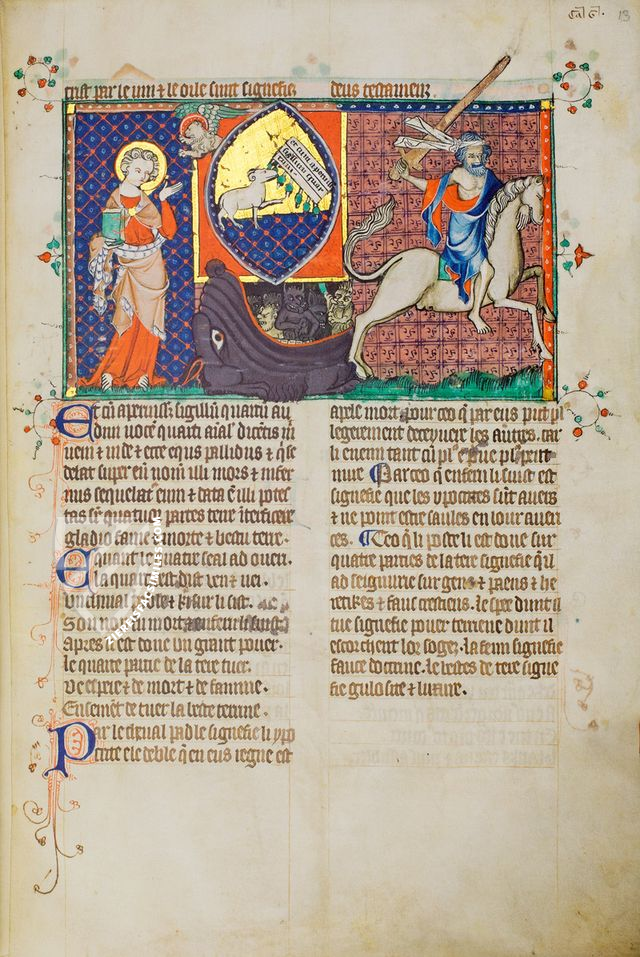
#1 Corpus-Christi-Apokalypse
Languages: English, German
(3,000€ - 7,000€)
- Treatises / Secular Books
- Apocalypses / Beatus
- Astronomy / Astrology
- Bestiaries
- Bibles / Gospels
- Chronicles / History / Law
- Geography / Maps
- Saints' Lives
- Islam / Oriental
- Judaism / Hebrew
- Single Leaf Collections
- Leonardo da Vinci
- Literature / Poetry
- Liturgical Manuscripts
- Medicine / Botany / Alchemy
- Music
- Mythology / Prophecies
- Psalters
- Other Religious Books
- Games / Hunting
- Private Devotion Books
- Other Genres
- Afghanistan
- Armenia
- Austria
- Belgium
- Belize
- Bosnia and Herzegovina
- China
- Colombia
- Costa Rica
- Croatia
- Cyprus
- Czech Republic
- Denmark
- Egypt
- El Salvador
- Ethiopia
- France
- Germany
- Greece
- Guatemala
- Honduras
- Hungary
- India
- Iran
- Iraq
- Israel
- Italy
- Japan
- Jordan
- Kazakhstan
- Kyrgyzstan
- Lebanon
- Liechtenstein
- Luxembourg
- Mexico
- Morocco
- Netherlands
- Palestine
- Panama
- Peru
- Poland
- Portugal
- Romania
- Russia
- Serbia
- Spain
- Sri Lanka
- Sweden
- Switzerland
- Syria
- Tajikistan
- Turkey
- Turkmenistan
- Ukraine
- United Kingdom
- United States
- Uzbekistan
- Vatican City
- A. Oosthoek, van Holkema & Warendorf
- Aboca Museum
- Ajuntament de Valencia
- Akademie Verlag
- Akademische Druck- u. Verlagsanstalt (ADEVA)
- Aldo Ausilio Editore - Bottega d’Erasmo
- Alecto Historical Editions
- Alkuin Verlag
- Almqvist & Wiksell
- Amilcare Pizzi
- Andreas & Andreas Verlagsbuchhandlung
- Archa 90
- Archiv Verlag
- Archivi Edizioni
- Arnold Verlag
- ARS
- Ars Magna
- ArtCodex
- AyN Ediciones
- Azimuth Editions
- Badenia Verlag
- Bärenreiter-Verlag
- Belser Verlag
- Belser Verlag / WK Wertkontor
- Benziger Verlag
- Bernardinum Wydawnictwo
- BiblioGemma
- Biblioteca Apostolica Vaticana (Vaticanstadt, Vaticanstadt)
- Bibliotheca Palatina Faksimile Verlag
- Bibliotheca Rara
- Boydell & Brewer
- Bramante Edizioni
- Bredius Genootschap
- Brepols Publishers
- British Library
- C. Weckesser
- Caixa Catalunya
- Canesi
- CAPSA, Ars Scriptoria
- Caratzas Brothers, Publishers
- Carus Verlag
- Casamassima Libri
- Centrum Cartographie Verlag GmbH
- Chavane Verlag
- Christian Brandstätter Verlag
- Circulo Cientifico
- Club Bibliófilo Versol
- Club du Livre
- CM Editores
- Collegium Graphicum
- Collezione Apocrifa Da Vinci
- Comissão Nacional para as Comemorações dos Descobrimentos Portugueses
- Coron Verlag
- Corvina
- CTHS
- D. S. Brewer
- Damon
- De Agostini/UTET
- De Nederlandsche Boekhandel
- De Schutter
- Deuschle & Stemmle
- Deutscher Verlag für Kunstwissenschaft
- DIAMM
- Droz
- E. Schreiber Graphische Kunstanstalten
- Ediciones Boreal
- Ediciones Grial
- Ediclube
- Edições Inapa
- Edilan
- Editalia
- Edition Deuschle
- Edition Georg Popp
- Edition Leipzig
- Edition Libri Illustri
- Editiones Reales Sitios S. L.
- Éditions de l'Oiseau Lyre
- Editions Medicina Rara
- Editorial Casariego
- Editorial Mintzoa
- Editrice Antenore
- Editrice Velar
- Edizioni Edison
- Egeria, S.L.
- Eikon Editores
- Electa
- Emery Walker Limited
- Enciclopèdia Catalana
- Eos-Verlag
- Ephesus Publishing
- Ernst Battenberg
- Eugrammia Press
- Extraordinary Editions
- Fackelverlag
- Facsimila Art & Edition
- Facsimile Editions Ltd.
- Facsimilia Art & Edition Ebert KG
- Faksimile Verlag
- Feuermann Verlag
- Folger Shakespeare Library
- Franco Cosimo Panini Editore
- Friedrich Wittig Verlag
- Fundación Hullera Vasco-Leonesa
- G. Braziller
- Gabriele Mazzotta Editore
- Gebr. Mann Verlag
- Gesellschaft für graphische Industrie
- Getty Research Institute
- Giovanni Domenico de Rossi
- Giunti Editore
- Graffiti
- Grafica European Center of Fine Arts
- Guido Pressler
- Guillermo Blazquez
- Gustav Kiepenheuer
- H. N. Abrams
- Harrassowitz
- Harvard University Press
- Helikon
- Hendrickson Publishers
- Henning Oppermann
- Herder Verlag
- Hes & De Graaf Publishers
- Hoepli
- Holbein-Verlag
- Houghton Library
- Hugo Schmidt Verlag
- Idion Verlag
- Il Bulino, edizioni d'arte
- ILte
- Imago
- Insel Verlag
- Insel-Verlag Anton Kippenberger
- Instituto de Estudios Altoaragoneses
- Instituto Nacional de Antropología e Historia
- Introligatornia Budnik Jerzy
- Istituto dell'Enciclopedia Italiana - Treccani
- Istituto Ellenico di Studi Bizantini e Postbizantini
- Istituto Geografico De Agostini
- Istituto Poligrafico e Zecca dello Stato
- Italarte Art Establishments
- Jan Thorbecke Verlag
- Johnson Reprint Corporation
- Josef Stocker
- Josef Stocker-Schmid
- Jugoslavija
- Karl W. Hiersemann
- Kasper Straube
- Kaydeda Ediciones
- Kindler Verlag / Coron Verlag
- Kodansha International Ltd.
- Konrad Kölbl Verlag
- Kurt Wolff Verlag
- La Liberia dello Stato
- La Linea Editrice
- La Meta Editore
- Lambert Schneider
- Landeskreditbank Baden-Württemberg
- Leo S. Olschki
- Les Incunables
- Liber Artis
- Library of Congress
- Libreria Musicale Italiana
- Lichtdruck
- Lito Immagine Editore
- Lumen Artis
- Lund Humphries
- M. Moleiro Editor
- Maison des Sciences de l'homme et de la société de Poitiers
- Manuscriptum
- Martinus Nijhoff
- Maruzen-Yushodo Co. Ltd.
- MASA
- Massada Publishers
- McGraw-Hill
- Metropolitan Museum of Art
- Militos
- Millennium Liber
- Müller & Schindler
- Nahar - Stavit
- Nahar and Steimatzky
- National Library of Wales
- Neri Pozza
- Nova Charta
- Oceanum Verlag
- Odeon
- Orbis Mediaevalis
- Orbis Pictus
- Österreichische Staatsdruckerei
- Oxford University Press
- Pageant Books
- Parzellers Buchverlag
- Patrimonio Ediciones
- Pattloch Verlag
- PIAF
- Pieper Verlag
- Plon-Nourrit et cie
- Poligrafiche Bolis
- Presses Universitaires de Strasbourg
- Prestel Verlag
- Princeton University Press
- Prisma Verlag
- Priuli & Verlucca, editori
- Pro Sport Verlag
- Propyläen Verlag
- Pytheas Books
- Quaternio Verlag Luzern
- Reales Sitios
- Recht-Verlag
- Reichert Verlag
- Reichsdruckerei
- Reprint Verlag
- Riehn & Reusch
- Roberto Vattori Editore
- Rosenkilde and Bagger
- Roxburghe Club
- Salerno Editrice
- Saltellus Press
- Sandoz
- Sarajevo Svjetlost
- Schöck ArtPrint Kft.
- Schulsinger Brothers
- Scolar Press
- Scrinium
- Scripta Maneant
- Scriptorium
- Shazar
- Siloé, arte y bibliofilia
- SISMEL - Edizioni del Galluzzo
- Sociedad Mexicana de Antropología
- Société des Bibliophiles & Iconophiles de Belgique
- Soncin Publishing
- Sorli Ediciones
- Stainer and Bell
- Studer
- Styria Verlag
- Sumptibus Pragopress
- Szegedi Tudomànyegyetem
- Taberna Libraria
- Tarshish Books
- Taschen
- Tempus Libri
- Testimonio Compañía Editorial
- Thames and Hudson
- The Clear Vue Publishing Partnership Limited
- The Facsimile Codex
- The Folio Society
- The Marquess of Normanby
- The Richard III and Yorkist History Trust
- Tip.Le.Co
- TouchArt
- TREC Publishing House
- TRI Publishing Co.
- Trident Editore
- Tuliba Collection
- Typis Regiae Officinae Polygraphicae
- Union Verlag Berlin
- Universidad de Granada
- University of California Press
- University of Chicago Press
- Urs Graf
- Vallecchi
- Van Wijnen
- VCH, Acta Humaniora
- VDI Verlag
- VEB Deutscher Verlag für Musik
- Verlag Anton Pustet / Andreas Verlag
- Verlag Bibliophile Drucke Josef Stocker
- Verlag der Münchner Drucke
- Verlag für Regionalgeschichte
- Verlag Styria
- Vicent Garcia Editores
- W. Turnowski Ltd.
- W. Turnowsky
- Waanders Printers
- Wiener Mechitharisten-Congregation (Wien, Österreich)
- Wissenschaftliche Buchgesellschaft
- Wissenschaftliche Verlagsgesellschaft
- Wydawnictwo Dolnoslaskie
- Xuntanza Editorial
- Zakład Narodowy
- Zollikofer AG

